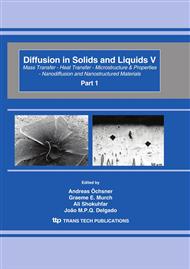p.771
p.779
p.785
p.790
p.796
p.802
p.808
p.814
p.820
Reaction Diffusion in Pb Free Solder-Cu System
Abstract:
Reaction diffusion in liquid Pb free solder- and solid Pb free solder- pure Cu systems has been investigated in the temperature range between 397 K and 563 K. The Pb free solder of which composition is 95.7 mass% Sn, 2.8 mass% Ag, 1.0 mass% Bi and 0.5 mass% Cu and 99.99 mass% oxygen free Cu has been used. In the liquid Pb free solder-pure Cu system, as soon as the solder melted down, an intermetallic compound phase formed preferentially, and grew with increasing diffusion time. Only the phase exists in the experimental time up to 120 seconds. The layer thickness of the phase obeyed the parabolic law. On the other hand, in the solid Pb free solder-pure Cu system two intermetallic compounds phase and ’ phase form and grew with increasing diffusion time, although the phase forms after an incubation time at low temperature. The layer thickness of these intermetallic compounds obeyed the parabolic law. The growth rate of ’ phase is greater than that of the phase. The growth kinetics of the intermetallic compounds and the diffusion behavior in the ’ phase have been investigated.
Info:
Periodical:
Pages:
796-801
Citation:
Online since:
April 2010
Authors:
Keywords:
Price:
Сopyright:
© 2010 Trans Tech Publications Ltd. All Rights Reserved
Share:
Citation:


